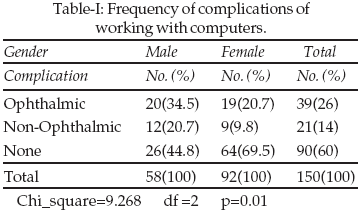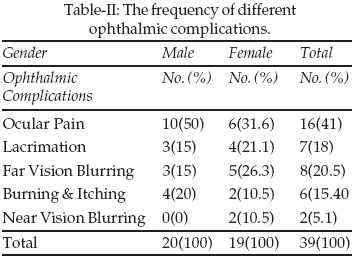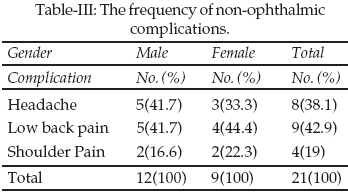Evaluation of the frequency of
complications of
working with computers in a group of
young adult computer users
Mohammad Ghassemi- Broumand1, Mona Ayatollahi2
ABSTRACT
Objective: To evaluate the complications of working
with computer in a group of students of computer sciences.
Methodology: In a descriptive-analytic study, we
evaluated 150 students (58 males and 92 females) 18 to 30 years of age who
worked with computers for two to twelve hours a day. The designed
questionnaires were handed out to the students and the data collected were
analyzed by the chi-square test.
Results: In these young adult computer users, the
complications were evident when duration of using computer exceeds two hours a
day. Ophthalmic complications and other complications (musculo-skeletal) were
present in 26% and 14% of the computer users, respectively. The most frequent
ophthalmic complication was ocular pain (41%) while the least common one was
blurred near vision (5.1%). The most common non-ophthalmic complications were
low back pain (42.9%) and headache (38.1%) and the least frequent one was
shoulder pain (19%).
Conclusion: Young adult computer users who work on
computers for more than two hours daily experience ophthalmic and musculo-skeletal
complications and frequency of the complications tends to increase in those
who work with computer daily.
KEY WORDS: Computers users, Ophthalmic Complications,
Musculo-skeletal disorders.
Pak J Med Sci October - December 2008
(Part-I) Vol. 24 No. 5 702-706
How to cite this article:
Ghassemi- Brouman M, Ayatollahi M. Evaluation of the frequency of
complications of working with computers in a group of young adult computer
users. Pak J Med Sci 2008;24(5):702-6.
1. Mohammad Ghassemi- Broumand, MD
Associate professor,
Ophthalmologist,
2. Mona Ayatollahi,
Optometrist,
1-2: Shahid Beheshti University (M.C),
Damavand Ave,
Tehran - Iran.
Correspondence
Dr. Mohammad Ghassemi-Broumand MD,
Associate Professor,
Ophthalmologist, Faculty of Rehabilitation,
Shahid Beheshti University (M.C),
Damavand Ave,
Tehran, Iran.
E-mail: m_ghbr_oph@yahoo.com
* Received for Publication: December 11, 2008
* Revision Received: July 23, 2008
* Final Revision Received: July 30, 2008
INTRODUCTION
Information technology has greatly developed and has been
widely integrated in all aspects of our daily life. After introduction of
computers in offices around twenty years ago, common activities in an office
including typing, reading, writing and archiving were replaced with sedentary
computer operating that increased the pace and efficacy of employees,
1
Following this trend, 15% of
American families had household computers in 1990, while this rate has
increased to 50% presently.2
Moreover, 75% of offices had computers in 2000.3
Thompson WD,
4
reported the frequency of ocular complaints to be 25-93% in computer users.
The symptoms resulted from working with computers are called computer eye
syndrome (CES). These manifestations include visual, ocular and general
symptoms. In addition, the study performed by Hales et al,5
showed that musculo-skeletal complications were present in 22% of the
patients. Musculo-skeletal manifestations are also called cumulative trauma
disorders (CTD) or repetitive strain injuries (RSI).6
The most common manifestations of
computer users are ophthalmic complications7-10
resulting from stimulation and
sensitivity of the eyes is ending in blurred vision, diplopia, and headache.
These symptoms are as common as 70-75% based on the report of Association of
Optometrists of the United States in 2003.11,12
The main cause of ophthalmic complications is tiredness of
cilliary and extra-ocular muscles. The other cause contributing to these
complications is ocular dryness due to long opening of eyes and central
concentration. Moreover, factors related to office design, lighting, computer
screen and its contrast, the distance with the screen and its angle are
influential in development of these symptoms, Psychiatric factors are also
important in developing these symptoms.
12,13
Disorders of accommodation and binocular vision, diplopia and retarded
focusing are,
more common in computer users in comparison with normal population.14
Khan & Siddiqui15
emphasized on musculoskeletal problem in computer user and they have reported
that low back pain is a common condition in computer users.
Since most common users of computers are students of
computer sciences, we decided to evaluate ophthalmic and other related
complications in these non-professional specific groups of population.
METHODOLOGY
This descriptive-analytic study conducted in 2006 was
performed enrolling one-hundred and fifteen computer sciences students of
Meybod Azad University in Iran Their age ranged from 18 to 30 years and they
were working on computers from two to twelve hours a day. The subjects did not
show any previous musculo-skeletal and eye problems. Evaluated ophthalmic
complications included ocular pain, lacrimation, blurring of vision (far and
near), burning and itching. Evaluated musculo-skeletal complications included
headache, backache, and shoulder pain. Each student was given a questionnaire
and the data collected were assessed separately for males and females. The
data were also assessed based on the working hours with computers. Statistical
analysis were performed with the SPSS for Windows. Data were analyzed by the
chi-square test. A P-value of <0.05 was considered significant.
RESULTS
One-hundred and fifteen computer science students (aged 18
to 30 years) including 92 females (61.3%) and 58 Males (38.7%) were enrolled
in this study. Duration of working with computers varied from two to twelve
hours. Sixty students (40%) showed the complications while the remaining 90
students (60%) did not manifest with any complications (Table-I).

Ocular pain (41%) was the most frequent ophthalmic
complication and near- vision blurring was the least frequent one (5.1%).
Non-ophthalmic complications included low back pain (42.9%), headache (38.1%)
and shoulder pain (19%). (Table-II & III)
Relative frequency of ophthalmic complications (26%) was
significantly (P<0.05) higher than non-ophthalmic complications (14%) in the
computer users. (Table-I). Males and females subjects did not show significant
difference (P>0.05, =0.05); as regards frequency of complications. However,
the difference between ophthalmic and non-ophthalmic complications in females
was significant (P<0.05).

Table-IV shows the frequencies of complications based on
daily working hours with computers. Students who worked with computers for
less than two hours a day did not manifest any complications, while both
ophthalmic and non-ophthalmic complications tend to increase with increase in
daily working hours with computers. However, this difference was not
significant in any of ophthalmic or non-ophthalmic complications (P<0.1,
P>0.05 respectively).

The ratio of ophthalmic to non-ophthalmic complications was
not significantly different based on different daily working hours (P>0.05).
Frequency of ophthalmic complications, burning and itching (P>0.05), and
lacrimation (P>0.05) were not significantly different in males and females.
However, gender difference was significant in frequencies of backache
(P<0.05), blurred vision (P<0.05) and headache (P<0.05).
The prevalence of ophthalmic complications was 260 in 1000
(133 in 1000 in males and 127 in 1000 in females) and the prevalence of
non-ophthalmic complications was 140 in 1000 (80 in 1000 in males and 60 in
1000 in females).

DISCUSSION
Our study showed that 26% of computer user who worked on
computers for more than two hours daily developed ophthalmic complications
while 14% developed musculo – skeletal disorders.
Many researchers have studied complications of working with
computer.
1,3-5,9,15-18
In some studies,1,3,4,7,11,17,18
ophthalmic complications and in others,5,15
musculo-skeletal complications
have been reported. A few studies have focused on both the complications.8,16
We tried to evaluate both
ophthalmic and non-ophthalmic complications of working with computer in a
young adult population. Clayton et al.1
who investigated 70 million
Americans working with computers for more than two hours daily showed that
ophthalmic manifestations were present in 90% of the cases. In our study, 26%
of the computer users with daily working more than two hours had o phthalmic
symptoms. Thompson WD,4
has reported the prevalence of ophthalmic complaints to range from 25 to 93%
while in our study ophthalmic complications were 26%.
American Society of Optometrists (ASO) has reported that
ophthalmic complications were present in 70-75% of computer users.
11
The study of Talia and Bruce, 17
investigating 2700 radiologists showed that ophthalmic complaints were present
in 36% of them. The study of Biljana et al,
18 investigating 690 cases for
eye dryness and its risk factors (e.g. watching TV, working with computers,
etc.) showed that a third of the cases (32-90 years of age) suffered from eye
dryness with odds ratio of 3.37 (95% CI of 2.11-5.38 with P<0.01). In our
study, Eye dryness was not considered as an ophthalmic symptom. Although we
have not assessed severity of ophthalmic symptoms and it correlation with
daily duration of working with computer, the computer users with daily working
less than two hours showed no complications but those who work for more than
two hours had more ophthalmic and non-ophthalmic complications as shown in our
study.
The prevalence of musculo-skeletal complications was 22% in
the study of Hales et al
5
which is comparable with our result 14%. Khan and Siddiqui evaluated computer
user for low back pain in patients 12-65 years. According to their results,
low back pain was reported in 44% of VDU user which developed after four hours
and in 35% after three hours.15
This is also similar to the
present study result (42.9%).
Study by Gunnarsson and Solderberg showed that the
intensity of complications due to working with VDU correlates with daily
working hours with computers.
16
The etiology of these
complications is widely diverse including underlying ophthalmic problems and
inappropriate ergonomic situation of offices.7
A study in 1992 showed that two third of these complications are due to
underlying ophthalmic conditions and the remaining third are because of
environmental factors.7,17
Another study in 1991 indicated that computer users experience more medical
problems in the same environment as others.7
From epidemiologic point of view, the prevalence of
ophthalmic complications as a result of working with computers was 260 in 1000
in our study (133 in 1000 in males and 127 in 1000 in females). The prevalence
of non-ophthalmic complications was 140 in 1000 (80 in 1000 males and 60 in
1000 females). In view of the increasing use of computer in world,
2,3
it is recommended that to prevent
these complications computer users have to be thoroughly trained regarding
ergonomics of the office (including lighting, chairs, desks, etc.), proper use
of computers (e.g. distance with the screen, view angle of the screen, sitting
position, etc.) and underlying ophthalmic situations that can be aggravated by
working with computers. Computer users should also be instructed to visit a
physician as soon as they experience any complication.
Considering the importance of complications of working with
computers, more extensive studies evaluating these complications in both
genders, in different age groups and in different occupations are recommended.
CONCLUSION
Young adult computer users working for more than two hours
daily experience various ophthalmic and musculo-skeletal complications.
ACKNOWLEDGEMENT
The authors wish to thank Mr. Mohammad-Ebrahim Mahdavi and
Mr. Pouria Ghassemi-Broumand for data analysis and all students of computer
sciences in Meybod Azad University for participation in the study.
REFERENCES
1. Clayton B, Seema V, Ashbala K. Computer vision syndrome:
A Review. J Survophthalmol 2005;50(3):253-62.
2. Sanders PA. Uniform veiling luminance and display
polarity effort VU user performance. Illumin Eng Soc 1990;113-23,199.
3. Costanza MA. Visual and Ocular symptoms related to the
use of video display terminals. J Behav Optom1994;5:31-6.
4. Thompson WD. Eye problems and visual display
terminals-the facts and fallacies. Ophthalmic Physiol Opt 1998;18(2):111-9.
5. Hales TR, Sauter SL, Peterson MR. Musculoskeletal
disorders among visual display terminal users in a telecommunications company.
Ergonomics 1994;37:1603-21.
6. Ghassemi-Broumand M, Akhgari M. Work and Eye. Tehran:
Teimurzadeh, 2007.
7. Bathaei A, Riazi M. Occupational eye Disorders. Tehran:
Shahd, 2005.
8. Ale-Taha M. Computer use complex. Iranian Negah J
Ophthalmol 2005;3(2):74-5.
9. Verna SB. Computers and vision. J Postgrad Med
2001;119-20.
10. Rachel V. North. Work and the Eye. Oxford Butterworth
Heinemann, 2001.
11. Kathy S. Tips for managing computer vision syndrome.
AAOHN J 2005;53:12.
12. Sauter S, Chapman LJ, Knutson SJ. Improving VDT work:
Causes and control of health concerns in VDT use. Madison, WI: Department of
Preventative Medicine, University of Wisconsin1984.
13. Lie J, Watten RF.VDT Work, Oculomotor strain and
subjective complaints: an experimental and clinical study. Ergonomics
1994;37:1419-33.
14. Mitchell S, Bruce W. Clinical management of Binocular
vision. Philadelphia: lippincton Williams, 2002.
15. Khan MY, Siddiqui MA. Prevalence of low back pain in
computer users, Pak J Med Sci 2005;21:159-163.
16. Gunnarsson E, Soderberg I. Eye strain resulting from
VDU work at the Swedish telecommunications Administration. Appl Ergon
1983;14:61-9.
17. Talia V, Bruce F. Prevalence of eye strain among
Radiologists: influence of viewing nariamles on symptoms. Am J Roentgenol
2005;84:681-6.
18. Biljana M, Reza D, David A. Impact of dry eye syndrome on
vision-related quality of life. An J Ophthalmol 2007;143(3):409-15.




